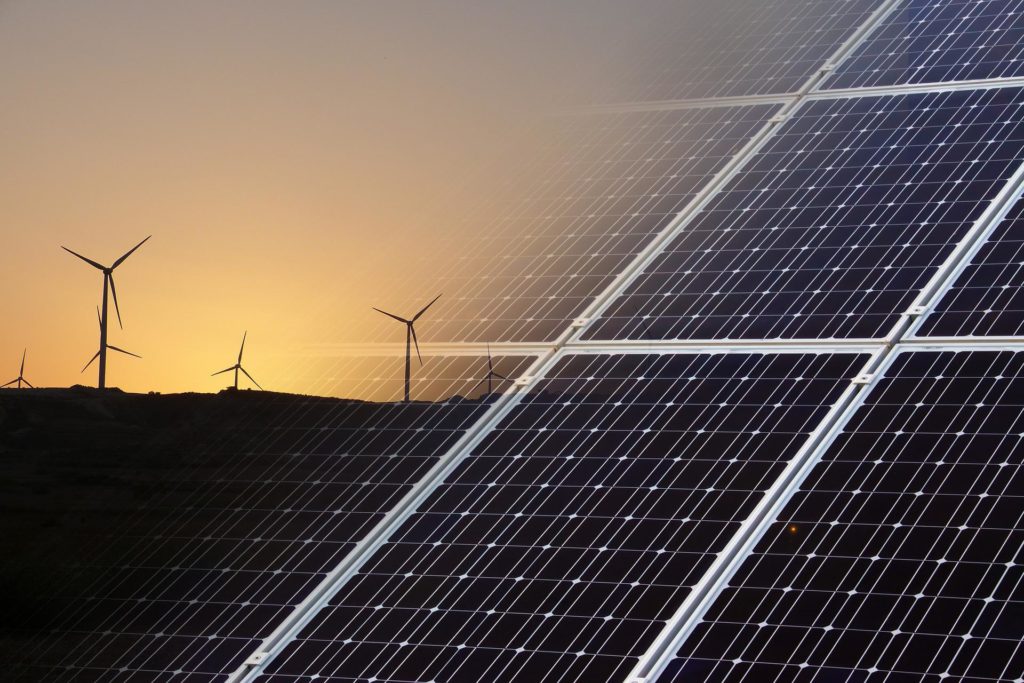TRANSCRIPT
James Lawler: [00:00:00] Welcome to Climate Now, a that podcast explores and explains the ideas, technologies, and the solutions that we’ll need to address the climate crisis and reach a zero emissions future. I’m James Lawler, and to sign up for a newsletter, which goes out every Tuesday morning with the link to the latest podcast episode, background information, relevant links, go to climatenow.com. To get in touch with us, email us at contact@climatenow.com. We always love to hear from our listeners so don’t be shy.
For today’s episode it’s the beginning of the end for the fossil fuel economy, at least according to the research of our two guests. The first is Kingsmill Bond of green energy think tank, RMI, whose recent work suggests that the global fossil fuel market is past its prime.
Next, Nat Bullard, a veteran energy analyst and regular author for Bloomberg Green, will discuss the potential technologies, industries, and policies that could shape the future of a net zero world. But first, our new segment this week in Climate News.[00:01:00]…
Now for our interviews. Kingsmill Bond of RMI says that the fossil fuel economy’s best days are behind it. Kingsmill spent decades as a stock market analyst in markets in Europe, Asia, and South America. And though he was initially skeptical of the wind and solar energy industries, he became increasingly interested in their market potential.
Eventually, he joined Clean Energy Think Tank RMI as a researcher. He’s now RMI’s senior principal energy strategist. His recent report titled Peak Fossil Fuel Demand for Electricity suggests that fossil fuel demand for electricity has peaked for 95% of the OECD member states and for 31% of non OECD countries.
I ask Kingsmill what this means exactly for the future of fossil fuels and for the wind, solar, and other sustainable energy alternatives that are replacing them. Kingsmill, [00:02:00] welcome to Climate Now it’s great to have you on our podcast today.
Kingsmill Bond: Thanks for having me, James.
James Lawler: So, Kingsmill, you recently co-authored a report which was entitled Peak Fossil Fuel Demand for Electricity. So, I’m wondering if you could explain what exactly peak fossil fuel demand for electricity is. Let’s start there, and then perhaps the findings of your report.
Kingsmill Bond: Sure. In any transition, the peak of the old is an important signal of change. That’s why we’re focusing on it. And after the peak, three things happen.
First of all, all of the growth is in the new technology, kind of by definition. Secondly, the old technology bounces along a plateau for a while, but then enters into decline, and that decline becomes kind of quite quick eventually. And then thirdly, because of these two things, you get feedback loops. So, feedback loops mean that basically take the car sector, car companies now see the future as electric vehicles. So they stop investing in their ICE platforms. They put all of their money into EV [00:03:00] platforms and, and therefore that speeds up change.
So once you get to the peak, you have these really important feedback loops. It particularly applies to financial markets. You know, my narrow specialty because, and, and George Soros even has a word for this, reflexivity, you know, financial markets are paid to look to the future. And as they see one future, which is different than they, they invest accordingly in their investment in and of itself, drives change. And so therefore, when we are looking at the electricity sector now at a global level, we would suggest that we’ve seen a peak in fossil fuel demand in the electricity system.
And by the middle of this decade, by about 2025, the demand for fossil fuels in electricity will start to decline actually quite quickly by about 4% a year by the second half of this decade. And what that means is that there’s simply not enough space left for fossil fuel demand in electricity to grow because this other stuff is growing so quickly.
So, people often say to me, you know, there are individual countries and areas and territories where there’s growth. Which is continuing, of [00:04:00] course that’s the case. But as with anything else in life, you know, you have areas of growth and areas of decline. And you know, our job as strategists and system thinkers is to net up the two and see what’s going on the systems level.
And it’s absolutely clear that the systems level, we, we’ve reached this, this, this peak in demand for fossil fuels in the electricity system. And as I say, we’re gonna bounce along, plateau for a while, but what’s happening if I go back to my math for a second, if solar and wind are generating 600 terawatt hours of incremental electricity supply, and then nuclear and hydro adding another 150 or at 750 and global electricity demand growth, even at 3% is not gonna be more than 900 terawatt hours. And, and that is really the point where there’s just no room left for demand for, for fossil fuels.
There are course far greater experts than, than myself, you know, both RMI and at many other institutions. I mean, I, I point your listeners to some great work done by NREL in the US, um, which I’m [00:05:00] sure many people have listened to, and their basic point is that solar and wind are part of an electricity system. And, as part of an electricity system with many other technologies, you can certainly take them up to 70% or 80% of the system without incurring excess costs.
And, and the point then I make as a strategist, I’m like, look, folks, 12% today of the system is now solar and wind. So the kind of ceiling of opportunity is far above our heads.
James Lawler: When you say we could take solar and wind up to about 70% to 80% of our energy production system, what do you mean by that?
Kingsmill Bond: Well, in fact, I was thinking specifically 70% to 80% of electricity generation. There’s a separate debate how far electricity itself can supply all of our energy, and it’s also quite clear, for what it’s worth, that electricity will grow over time. But with [00:06:00] within the electricity system, 70% to 80% is extremely feasible.
You already have countries or regions such as Denmark and Northern Germany and Australia and Ireland already planning for that level. And the way they do it, like again, I kind of defer to people more expert than than I am, but the way they do it, they basically, it’s a kind of combination of demand side response, supply side response, large amounts of capacity, some batteries, some storage through hydro and, and other solutions and, and better forecasting and, and limited use of fossil fuels for the moments where it’s most difficult.
That incidentally, for me as a strategist is, is not a problem at all. The 5% of the system, whatever the number might be, to be fossil fuels in, in the thinking of 2023, because again, we are so far away from these barriers. We have a system that’s so heavily dependent today upon fossil fuels that what really [00:07:00] matters is not the, the boring debate about the end game in 2050, but what’s happening right now.
James Lawler: Mm-hmm. Now, some people say about the, this huge expansion of renewables that. Where are we gonna put it all? The land use constraints, for example, is how are countries like Ireland and places that might be a bit more land constrained dealing with this?
Kingsmill Bond: If I may to go on a little bit of a limb, first of all, we have today 100 times as much land available for the deployment of solar and wind technology as we need for all of our energy 100 times. So, you know, do the math. Therefore 1% of our entire land mass is all that you would need for all of humanities desire for all energy sources today. And, and you know, that data is very, easy to calculate.
You can do it with, with data from, um, [00:08:00] Solargis and, and NREL, I’ve done it myself. So we, you know, we can establish that you need less than 1% of your total land mass to generate all of our energy and, and then you start looking around the world. Well, Mark Jacobson has calculated that in the US for example, the fossil fuel sector is using more than 1% of the United States land mass for its energy.
So actually, these two numbers are roughly comparable because you need space for your mines, you need space for your pipelines, you need space for your exclusion zones, all the rest of it.
James Lawler: Mm-hmm.
Kingsmill Bond: So the numbers are actually quite comparable, but of course the difference is you can, you can graze sheep under solar panels, you can have farms next to wind turbines. It’s, it’s really not a genuine constraint. (Note a recent McKinsey article that suggests land is a major challenge for renewables growth) And then the, the other point is you can do this calculation of course, and we have done for every country in the world, and what becomes apparent is that it is true to say that there are 10 or [00:09:00] 15 countries which genuinely are quite land constrained. So if the global number is a hundred, most of the global south, it’s a thousand times as much renewable energy potential compared to their total energy demand today.
. But there are, there are this small group of countries, so Germany, Belgium, Netherlands, Singapore, Korea, and Japan.
They have a problem because it’s less than 10. That’s about 10% to 14% of global energy demand, and these are countries which have to think creatively. But listen to the list of countries. You know, these are countries which have got fabulous, innovative technology sectors, and they’re finding solutions. So, you know, they’re putting solar panels on all of their roofs.
They’re putting solar panels on their reservoirs. They’re [00:10:00] thinking of creative ways, in the case of Singapore, to import electricity through cables underwater. I mean, so there are solutions even for that group of countries. This human ingenuity and discovery of this enormous cheap energy resource is that we will exploit it one way or another.
James Lawler: Yeah.
Kingsmill Bond: Come what may, and I think this is a general, general point about the barriers to change that people raise. You know, the question we always ask people at RMI, about the barriers to change, is are they universal or, or specific? Are they immediate or some potential moment in, in the future? And are they insoluble or do we have the glimmerings of a solution?
And when, when you ask those three questions, it becomes very quickly apparent that actually there are solutions. People are deploying this, this stuff, and that a lot of the arguments about why change can’t happen are very theoretical and they’re set, you know, some far distant date in the future.
And they’re just not, they’re not real. In the last decade, we’ve [00:11:00] solved the technology problems. We’ve solved the economic problems. Now the only thing we have left is policy issues. It’s much easier, at least it should be much easier for politicians and policy makers to solve those policy issues.
James Lawler: Kingsmill Bonds research makes a compelling case that the demand for fossil fuels will continue to drop.
Wind and solar alone could account for 70% to 80% of the global power mix. But what will it take to get there? In looking for the answer, we came across a presentation by analyst, Nat Bullard, who has spent 15 years at the organization that would become Bloomberg Sustainable Energy Research arm, Bloomberg NEF.
Nat has recently become an independent consultant and speaker, though he still regularly writes for Bloomberg Green. In January, Nat published a presentation called Decarbonization the Longview Trends and Transients Net Zero. It’s a kind of state of the union address for decarbonization, combining the latest technology, politics, economics, and other factors for a truly comprehensive take.[00:12:00]
I highly recommend checking it out at nathanielbullard.com/presentations. Nat was gracious enough to give us a summary of his findings. He said it’s clear that the global energy economy is changing and fast. That’s inevitable. Question is how should we respond to that change?
Nat Bullard: How do we conceive of a change that in one sense feels like it is an evolution. So after we’ve gone from doing sort of bespoke little renewable energy projects to sort of a more involved and more evolved energy transition in big companies to then getting everybody to know emissions by the middle of the century. It feels like it’s the next step, but it is so much more than that.
Yes, we’ve more or less peaked our inputs of fossil fuels into this system, and all of the growth is coming from things that are, that are zero carbon, that’s coming for the most part, from renewable power, but it’s also coming in the United States from biofuels as [00:13:00] well. But that’s – it’s important, right?
It means you’re at a long plateau potentially. That then really, it’s up to technology and policy to inflect and force downwards. But you’re also at the point where like all of the growth is coming from these areas.
James Lawler: And what about globally? Is that fact consistent around the world that growth and primary energy demand is, is being met through renewables?
Nat Bullard: Not quite, so it’s not quite there. We’ve got big, bigger systems in the US that are still very much growing. They’re top line of primary energy. On the electricity side though, it’s, it’s getting closer and closer to the point where all incremental demand is being met by renewables.
We’re at the point where, you know, approaching 80% of the growth in electricity demand is being met by, by renewables. And then related to that is that in the transport sector, all of the, the growth in the sale of automobiles is electric. [00:14:00]
James Lawler: At this point. I asked Nat to share his own projections on what’s next for the energy sector, but there’s a big caveat here.
Economic forecasts are notoriously bad at actually deciphering the future. Nat’s aforementioned presentation has a whole section upfront about how decades old forecasts about American power consumption turned out to be completely off the mark. Nevertheless, Nat says economic models are still very useful for understanding present day markets and preparing for contingencies, even if the future itself remains a mystery.
Thus, it was worth hazarding a few educated guesses about where the global energy industry could be headed.
Nat Bullard: You sort of can come up with all kinds of rationales, all kinds of mechanisms for thinking about why these markets might not grow in the future. But what has proven most durable is to simply fit a logistic curve to the pattern that’s already happening.
You know, and to say, look, these are the sort of the smoothest deployment curves of a, of a technology in terms of its delivered energy, ever. [00:15:00] Right? You know, nuclear power rises and then stops, right? Gas and coal bump into each other over time. Hydro has a, it hits a level and moves very slowly. But these two things move on a logistic curve that looks, you know, it looks like this, we’re in the steep part of it turning into an S-curve.
James Lawler: So the two things being solar and wind?
Nat Bullard: Solar and wind, solar and wind.
James Lawler: Mm-hmm.
Nat Bullard: We’re looking at electric vehicles being similar in terms of their share of sales. We’re looking at EV, electricity storage, usually in the form of lithium-ion storage batteries also following a similar curve.
James Lawler: Why is that? You know why do some of these technologies like solar and wind, you know, people will say, oh, it’s because they were subsidized, or it’s because of this or that, but other things are subsidized too. Like why, why has that happened?
Nat Bullard: The main reason is that they improve in efficiency over time. They decrease in cost as a function of how much they’re manufactured. And this becomes a virtuous cycle. They get cheaper [00:16:00] because they’re getting better ,and we do more of them. Which makes them cheaper. Which makes us do more of it, which makes them better. And, and they’re also at a price point in terms of the delivered energy from them that certainly on the margin is the, usually the cheapest electricity anywhere.
So that’s, that’s part of it. There’s also a great deal of competition between the providers of, of these technologies. There are many providers, they’re competing intensely with each other. And there’s a lot of process innovation, if I will.
Like there’s, you know, we’re not actually in a good way, dependent upon some sort of fundamental breakthrough. You know, we don’t need the cold fusion equivalent. We simply need to grind the gears ever more fine on making things by the hundreds of millions, in the case of solar panels and batteries, billions, perhaps every year.
And so those characteristics are, are important to note. You know, and related to that is that there was a study that I saw from, from Oxford Institute for New Economic Thinking, that there are also things that do not [00:17:00] improve over time. You know, one, one of the charts he was talking about, and things that surprised me in my findings is that the useful cost of energy from coal so expressed in megawatt hour terms has pretty much not moved in 125 years,
James Lawler: The useful cost. What, so what does that mean exactly?
Nat Bullard: So that means that like, when you get to the point of delivering that, not just the cost of coal, you know, the input, but the electricity that comes out of it, you know, something that people are then going to use, it basically hasn’t moved. You cannot change the nature of coal.
James Lawler: Right.
Nat Bullard: You know, you can’t. Like the energy value within it can be extracted more efficiently, but it itself is not changing. And all of the technologies that do transform it into something are impacted by commodity prices over time, by trade flows and things like that. And the result is that like they haven’t improved.
James Lawler: Right. Now one question I’ve had about the decarbonization of the power market has to do with distribution. To what degree will power generation [00:18:00] happen in a distributed fashion where you have solar panels on homes and industrial parks powered by microgrids and you know, every mall, every sort of commercial building has solar versus large scale deployments, utility scale deployments that require significant transmission infrastructure? What do some of the numbers and trend lines tell us about where that’s likely to end up in your view?
Nat Bullard: To my mind, it’s really a big question about transmission more than anything, as the determinant of what gets built where. And I say that because almost in every instance, the utility scale power generation from renewable assets is going to be cheaper than anything that is smaller and built into the distribution grid.
And if your cost to interconnect it is sufficiently low, then that makes the most sense. But if those don’t, you know, if that that other element, if transmission does not happen, then I think things will find their way forced further into the distribution grid, [00:19:00] competing with the economics of the power that gets delivered to end users, rather than the power that gets generated and put into the grid by large power generation assets.
James Lawler: Right.
Nat Bullard I feel like that’s not a very satisfying answer because it’s actually not a very satisfying outcome either in the sense that like this is an inflection that is dependent upon things that are not within the realm of some kind of disruptive innovation. They’re not within the realm of inventing one’s way out of the problem.
It’s really a question of is there willpower and broadly conceived capability to do things in the policy planning permission, capital markets realms to accelerate what’s there?
James Lawler: What do you think will happen? Do you think that we’ll figure that out?
Nat Bullard: I’m, I’m cautiously optimistic that we will, that we will figure it [00:20:00] out because I think it’s been, it’s been given the sense that it’s, it’s an imperative that aligns nicely to an extent across the political spectrum, which is we need, we need planning and permission for energy assets.
And, you know, if you have to make a sort of a grand bargain to do that, you have, you know, you’ll, you’ll receive a pipeline here and there in exchange for building, you know, hundreds of gigawatts worth of new transmission capacity
James Lawler: Because as you just described, you know, we’ve got a huge amount of generation that if we can clean up these permitting rules, it’s gonna come online. It’s gonna be renewables that get built, not a huge amount of, not gas and-
Nat Bullard: That’s right. I delivered a slide for a visiting business delegation about a month ago. And you know, the covers that I, I put up two magazine covers that were published at almost the same time, and one is the cover of the Economist, sort of, you know, archetypal kind of center right, small sea, conservative, intellectual, [00:21:00] conservative magazine.
James Lawler: Mm-hmm.
Nat Bullard: That has somebody hugging a transmission pylon. And then the other one is Mother Jones magazine, which has somebody hugging a bucket, the bucket and, and loader and nift of an excavator like, and they’re basically both saying the same things; it’s time to get things built, like learn to love infrastructure.
There’s not actually a way to transform our current system if you believe that that needs to be done by not doing things. Like it will slowly kind of grind fine over time and change elements of itself. But, if you want to be transformational, that requires doing quite a bit.
James Lawler: So the Inflation Reduction Act, some call it the biggest, you know, climate bill of all time. Some I’ve heard, I’ve heard one talk on, on how it’s really just a domestic sort of production subsidy or stimulus bill, what impacts do you find to be the most interesting coming out of the early [00:22:00] innings of the deployment of this bill?
Nat Bullard: I think that we’re just beginning to understand exactly what’s in the IRA. You know, some of the incentives within it are uncapped. Others of them last for a decade at a time. And so the market, essentially the market has been given a latticework. And or, or a skeletal structure in the form of policy.
It reminds, it reminds me of a very funny scientific meme, which is if you were to give, you know, an an illustrator, a skull of a hippopotamus, what kind of, what kind of horrendous monster would you actually generate from looking at this, this large skull with protruding teeth, you’d have some horrendously dangerous looking carnivore, but no, you get a hippo, right?
Like we don’t, we don’t actually know. We don’t know the soft tissue that that’s gonna be fully built upon this. And as an element of that, we, we don’t really, we don’t know yet which things, what industries I think are gonna be created by it. My inkling is that like [00:23:00] the incentives around hydrogen in particular are going to essentially will some industries into being by virtue of the largest of the policies, that might not have otherwise happened.
What we need to watch is like where are announcements being made specifically because of that. What parts of the country, what kinds of capacities are being built, what things are being brought to the US that left? What things are being built for the first time here? You know, and how is it. You know, how is it creating new industries?
Where are there models that are being built specifically on the back of the new affordances and allowances that come from the IRA?
James Lawler: Well Nat, I just wanna thank you so much for joining us. This was really a great conversation. I appreciate you spending time with us today.
Nat Bullard: Thanks, James. My pleasure.
James Lawler: That was Nat Bullard, an independent consultant, columnist for Bloomberg Green, senior contributor to Bloomberg NEF, and Venture partner at Voyager Ventures. And earlier in the episode, you heard from Kingsmill Bond, Principal Energy [00:24:00] Strategist at the Clean Energy Think Tank, RMI. That’s it for this episode of the Climate Now Podcast.
To learn more about the potential future of the energy sector, check out our other podcast conversations @climatenow.com. And if you’d like to get in touch, email us @contactclimatenow.com or tweet us @weareclimatenow. We hope you’ll join us for our next conversation.








